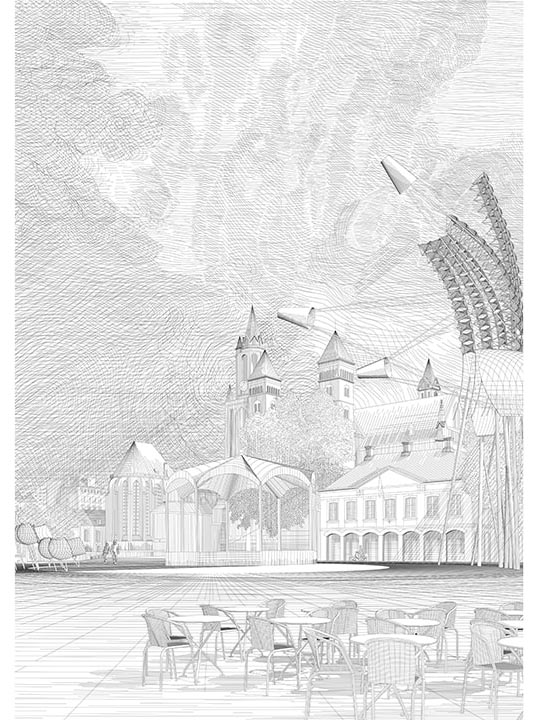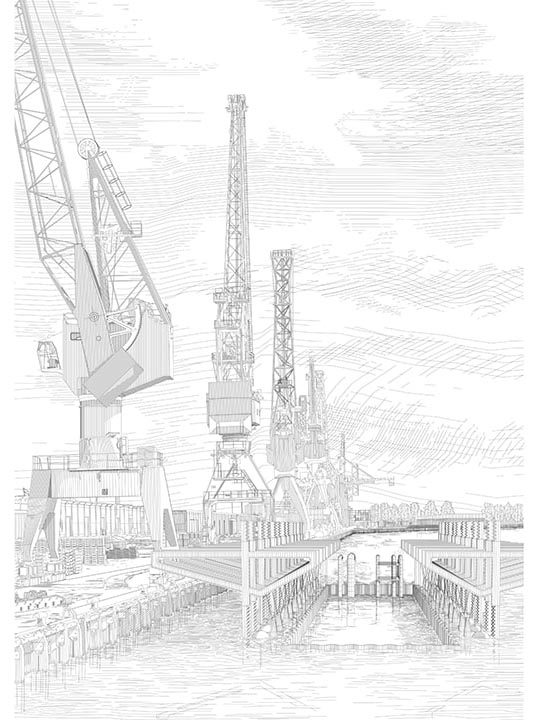Weerkas
Weerkas
Weerkas considers how architecture might express environmental changes. The project was completed as part of an open call for the 6th International Architecture Biennale Rotterdam 2014 (IABR 2014). Curated by Dirk Sijmons, the theme of the Biennale was “Urban by Nature”. Weerkas was specifically developed to express climatic changes in the Netherlands. Loosely translated into English as ‘Weather-house’, the Weerkas is not a ‘house’ (huis) in a domestic sense, but a translation of a greenhouse (kas), a place where weather and interior climate are tightly controlled. The project is a commentary on changing weather patterns, and its latent effects on the Dutch socio-cultural milieu. The underlying narrative notes that while the Netherlands is overly accomplished at exerting control of its land and water management, over the course of the coming decades the changing weather will make this management increasingly difficult to predict and control. These changes not only affect the economy, but also result in a series of critical social changes. The winter landscapes so beautifully expressed in classical paintings will be relegated to experiences of the past. For us to understand the full implication of climate change we have to express a holistic understanding. One that connects climate to economy and culture.
The Weerkas was expressed in twelve digital etchings completed with my project assistant, Aisha Sawatsky and etched on Arches paper by Mark Herschede at Haven Press Studio in Brooklyn. The small interventions in each drawing are didactic ‘follies’, one for each month of the year, and one for each province in the Netherlands. It was critical to locate each folly in a specific place. These structures narrate the increasing disparity between current and historic climate cycles, so that the public can see, hear, feel, and touch the difference of climate change.
The expression of each architectural intervention oscillates between structured research, formally expressed through irony, humor and subversion. In using art as a means to understand the science of climate change, this architectural project aims to visualize the scale, complexity and variability of this centuries most pressing issue.
Ijskas, January, Groningen (Groningen)
The Ijskas is a mechanism to manufacture ice. As the ice sheet becomes established the majority of the machines are moved to the periphery to extend the skating surface along the length of the canal. The machines are necessary because rising winter temperatures are greatly reducing the formation of natural ice. The issue becomes apparent when one sees the proximity of the ice skaters to open water and the machines needed to fabricate the cultural experience of skating in Groningen.
Windkas, February, Vlissingen (Zeeland)
Research is increasingly correlating temperature change as a result of changes in wind direction. Pertinent to the Dutch winter landscape is the increase in southerly winds raising the overall temperature. The Windkas expresses that change in wind direction using a series of funnels. As the wind enters the funnel it takes warm southerly air, cools it and accelerates it out in the right direction.
Sneeuwkas, March, Lochem (Gelderland)
The Sneeuwkas is located near Lochem along the River Berkel. Overlooking the thee koepel(tea house) van Staring, the folly uses air conditioners, chiller units and snow making machines to generate snow. This project recognizes the irony of using energy to recreate cultural experiences lost due to increase energy use. It perpetuates the cycle that is so damaging to the environment to retain climatic stasis. This irony questions what cultural activities will have to evolve for us to build in this new milieu.
Koelkas,April, Zwolle (Overijssel)
For the proper cultivation of cut flowers, a cooler April is preferred with monthly mean temperature of approx. 9 degrees centigrade. The structure acts like a large ambient air-cooling funnel. The air migrates between the metal tubes filled with cool water from the adjacent canal. As the air travels through the web the heat is passively removed.
Zandkas,May, Loonse & Drunense Duinen Nationale Park (Noord-Brabant)
Like a number of national parks in the Netherlands the internal sand dunes of the Loonse & Drunense Duinen are a unique ecology within the normative Dutch landscape. Due to extreme weather conditions and the increase of wind and water erosion these landscapes are under threat of deterioration. The cages of the Zandkas form a landscape ideal, they nurture the landscape within its protected shell to sustain these fragile environments. Outside the cage is an evolving landscape. The emerging contrast reinforces the cultivated notion of nature in the Netherlands.
Luchtkas, June, de Bilt (Utrecht)
Located near the KNMI Headquarters in De Bilt, the Luchtkas contains 36 barometers, one for each of the weather stations located throughout the Netherlands. The barometers are self-contained so they give what the air pressure should be, rather then its current condition. Barometers being the most common domestic device to determine variations in the weather this locked device acts as a beacon of climatic stasis.
Zonnenkas, July, Maastricht (Limburg)
The folly focuses on the bandstand in the middle of the Vrijthof. Surrounding the stand is a large rotating structure, which traces the daily sun path like a sunflower. When unusual weather patterns, such as unseasonal storms, or cloudy weather occur, this parabolic solar reflector uses either natural or artificial illumination to ensure that the center of the plaza remains sunny and warm.
Zeekas, August, Rotterdam (Zuid Holland)
The Zeekas is located in the Netherland's primary port and economic hub - Rotterdam. According to both the KNMI'06 Scenarios and the Delta Commission ocean water levels will rise by approx. 0.8 - 1.2m by 2100. The `pool' within the harbor moves vertically via a counterweight system. The water level can be adjusted to reflect times of flooding (when the normative water level would be lower then the current water level) or drought (when the normative water level would be higher then the current water level.
Plantenkas, September, Klazienaveen (Drenthe)
The greenhouse was the originally inspiration for the Weerkas project. The folly forms an outside counterpoint to the manufactured interior environment. Located sporadically throughout the greenhouse are a series of lightweight intrusions. These place a small number of plants outside of the greenhouse but visible from within. Without the aid of mechanized ventilation, temperature control, irrigation and fertilizer these plants are tasked with confronting nature without human intervention. It is side-by-side that the discrepancies of these two plants articulate the fabricated human interventions that define so much of the Dutch landscape.
Windkas, October, Almere (Flevoland)
This folly explores the affect of wind speed through the commercial districts of modern cities. These mechanisms indicate how fast the wind would be blowing if not affected by the surrounding buildings. It is hoped that this contrast of a light breezing mechanical grass, is off set by the unexpected gusts that can lurk behind urban corners. As wind gusts become more prevalent this folly acts as a visual aid in understanding how both climate change and urban development shape our external experience.
Regenkas, November, Haarlem (Noord Holland)
The Regenkas explores the transient, passive way we experience weather. Located at a place of transit it shows what the weather should be as oppose to current conditions. According to the KNMI, precipitation levels in the winter will rise by approx. 20%. Other seasons will also see a positive mean increase in precipitation. This folly normalizes those weather conditions but showing the historic mean. Thereby maybe, not raining when it is pouring outside or by raining in the station during periods of drought.
Wolkenkas, December, Oud-Vlieland (Friesland)
In a typical December, Vlieland will experience 90% cloud cover. If the real clouds become too dispersed these artificial clouds will fill with nitrogen to slowly reduce the solar glare.
In a country as developed as the Netherlands, urban nature is adjacent to cultural experience. Our urban regard for weather as a `natural' interloper to the city means we must understand how minute changes in the climate, can have a dramatic impact on the human condition.











